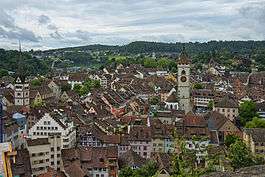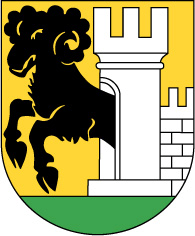Schaffhausen
| Schaffhausen | ||
|---|---|---|
|
Schaffhausen in 2012 | ||
| ||
 Schaffhausen | ||
|
Location of Schaffhausen 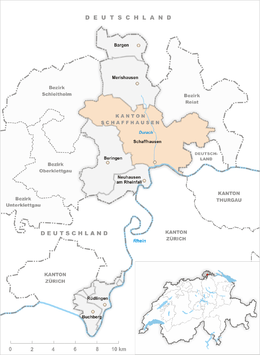 | ||
| Coordinates: 47°42′N 8°38′E / 47.700°N 8.633°ECoordinates: 47°42′N 8°38′E / 47.700°N 8.633°E | ||
| Country | Switzerland | |
| Canton | Schaffhausen | |
| District | (None in canton of Schaffhausen) | |
| Government | ||
| • Executive |
Stadtrat with 5 members | |
| • Mayor |
Stadtpräsident (list) Peter Neukomm SPS/PSS | |
| • Parliament |
Grosser Stadtrat with 36 members | |
| Area[1] | ||
| • Total | 41.86 km2 (16.16 sq mi) | |
| Elevation | 403 m (1,322 ft) | |
| Population (Dec 2015[2]) | ||
| • Total | 35,948 | |
| • Density | 860/km2 (2,200/sq mi) | |
| Postal code | 8200 | |
| SFOS number | 2939 | |
| Surrounded by | Beringen, Büsingen am Hochrhein (DE-BW), Büttenhardt, Dörflingen, Feuerthalen (ZH), Flurlingen (ZH), Hemmental, Merishausen, Neuhausen am Rheinfall, Stetten, Thayngen | |
| Twin towns | Sindelfingen (Germany), Singen am Hohentwiel (Germany), Dobrich (Bulgaria) | |
| Website |
www Profile (German), SFSO statistics | |
| Imperial City of Schaffhausen | ||||||||||
| Reichsstadt Schaffhausen | ||||||||||
| Free Imperial City of the Holy Roman Empire | ||||||||||
| ||||||||||
| Capital | Schaffhausen | |||||||||
| Government | Republic | |||||||||
| Historical era | Middle Ages | |||||||||
| • | Gained Reichsfreiheit | betw 1190 and 1218 | ||||||||
| • | Pledged to Habsburgs | 1330 | ||||||||
| • | Bought independence | 1415 | ||||||||
| • | Associate member of Swiss Confederacy |
1454 | ||||||||
| • | Joined Switzerland | 1501 | ||||||||
| • | Swiss independence recognised |
1648 | ||||||||
| ||||||||||
| Imperial Abbey of All Saints in Schaffhausen | ||||||||||
| Reichskloster Allerheiligen, Schaffhausen | ||||||||||
| Imperial Abbey of the Holy Roman Empire | ||||||||||
| ||||||||||
| Capital | Schaffhausen | |||||||||
| Government | Principality | |||||||||
| Historical era | Middle Ages | |||||||||
| • | Consecrated (Leo IX) | 22 November 1049 | ||||||||
| • | Papal grant of Nellenburg lands |
1080 | ||||||||
| • | Gained Hiltensweiler lands |
1122–1389 | ||||||||
| • | City became Swiss Associate |
1454 | ||||||||
| • | City joined Switz. | 1501 | ||||||||
| • | Converted to monastery and cathedral church |
1524 | ||||||||
| • | Disestablished in Reformation |
1529 | ||||||||
| ||||||||||
Schaffhausen (German: [ˈʃafˌhauzən]; Alemannic German: Schafuuse; French: Schaffhouse; Italian: Sciaffusa; Romansh: Schaffusa) is a town in northern Switzerland and the capital of the canton of the same name; it has an estimated population of 34,587 as of December 2008.[3]
The official language of Schaffhausen is the Swiss variety of Standard German, but the main spoken language is the local variety of Swiss German.
The old portion of the city has many fine Renaissance era buildings decorated with exterior frescos and sculpture, as well as the impressive old canton fortress, the Munot. A train runs out of town to the nearby Rhine Falls in Neuhausen am Rheinfall, Europe's largest waterfall, a tourist attraction.
Origin of the name
The town is first mentioned in 1045 as Villa Scafhusun. There are at least two theories on the origin of this name. One is related to a mention of a "ford" across the Rhine River that first occurs in 1050. This "ford" may actually refer to a scapha or skiff which was used to disembark goods coming from Constance to move them around the Rhine Falls. The name Scafhusun then arose from the scapha used at that point. Another theory is that Scafhusun comes from Schaf (a sheep), as a ram (now a sheep) formed the ancient arms of the town, derived from those of its founders, the counts of Nellenburg.[4]
Coat of arms
The blazon of the municipal coat of arms is Or on a Base Vert issuant from sinister a Semi Castle Argent with tower with entrance from which is issuing a Semi Ram Sable.[5] The canting coat of arms refers to the second interpretation of the name, sheep-house.
History
Schaffhausen was a city state in the Middle Ages, documented to have struck its own coins from 1045.[4] About 1050 the counts of Nellenburg founded the Benedictine monastery of All Saints, which became the centre of the town. Perhaps as early as 1190, certainly in 1208, it was an imperial free city, while the first seal dates from 1253. The powers of the abbot were gradually limited and in 1277 the Emperor Rudolf I gave the town a charter of liberties. In 1330 the emperor Louis of Bavaria pledged it to the Habsburgs. In the early 15th century, Habsburg power over the city waned. By 1411 the guilds ruled the city. Then, in 1415 the Habsburg Duke Frederick IV of Austria sided with the Antipope John XXIII at the Council of Constance, and was banned by the Emperor Sigismund. As a result of the ban and Frederick's need of money, Schaffhausen was able to buy its independence from the Habsburgs in 1418. The city allied with six of the Swiss confederates in 1454 and allied with a further two (Uri and Unterwalden) in 1479. Schaffhausen became a full member of the Old Swiss Confederacy in 1501.
The Reformation was adopted, initially, in 1524 and completely in 1529. The town was heavily damaged during the Thirty Years' War by the passage of Swedish (Protestant) and Bavarian (Roman Catholic) troops and the very important bridge was burnt down. It was not until the early 19th century that the arrested industrial development of the town made a fresh start.[4] In 1857 the first railroad, the Rheinfall-Bahn running from Winterthur, reached Schaffhausen.[6]
Schaffhausen is located in a finger of Swiss territory surrounded on three sides by Germany. On 1 April 1944 Schaffhausen suffered a bombing raid by United States Army Air Forces aircraft which strayed from German airspace into neutral Switzerland due to navigation errors. About a hundred civilians were killed;[7] the United States quickly offered four million dollars in reparations.
Geography and climate
Topography
The city of Schaffhausen stands on the right bank of the River Rhine. It has an area, (as of the 2004/09 survey) of 41.86 km2 (16.16 sq mi).[1] Of this area, about 20.2% is used for agricultural purposes, while 53.4% is forested. Of the rest of the land, 24.8% is settled (buildings or roads) and 1.6% is unproductive land. Over the past two decades (1979/85-2004/09) the amount of land that is settled has increased by 95 ha (230 acres) and the agricultural land has decreased by 117 ha (290 acres).[8]
In 1947 it merged with the former municipality of Buchthalen. Its area expanded again in 1964 when Herblingen was absorbed and for a third time in 2009 when Hemmental joined the municipality.[9]
Climate
Schaffhausen has an average of 122.5 days of rain or snow per year and on average receives 907 mm (35.7 in) of precipitation. The wettest month is July during which time Schaffhausen receives an average of 95 mm (3.7 in) of rain. During this month there is precipitation for an average of 11.3 days. The driest month of the year is February with an average of 59 mm (2.3 in) of precipitation over 8.4 days.[10]
| Climate data for Schaffhausen (Reference period 1981-2010) | |||||||||||||
|---|---|---|---|---|---|---|---|---|---|---|---|---|---|
| Month | Jan | Feb | Mar | Apr | May | Jun | Jul | Aug | Sep | Oct | Nov | Dec | Year |
| Average high °C (°F) | 2.6 (36.7) |
4.7 (40.5) |
9.9 (49.8) |
14.4 (57.9) |
19.2 (66.6) |
22.3 (72.1) |
24.7 (76.5) |
24.0 (75.2) |
19.4 (66.9) |
13.8 (56.8) |
7.0 (44.6) |
3.5 (38.3) |
13.8 (56.8) |
| Daily mean °C (°F) | 0.0 (32) |
1.1 (34) |
5.3 (41.5) |
9.2 (48.6) |
13.7 (56.7) |
16.8 (62.2) |
18.9 (66) |
18.3 (64.9) |
14.3 (57.7) |
9.7 (49.5) |
4.2 (39.6) |
1.2 (34.2) |
9.4 (48.9) |
| Average low °C (°F) | −2.4 (27.7) |
−2.0 (28.4) |
1.3 (34.3) |
4.4 (39.9) |
8.8 (47.8) |
11.9 (53.4) |
13.8 (56.8) |
13.5 (56.3) |
10.1 (50.2) |
6.4 (43.5) |
1.7 (35.1) |
−0.9 (30.4) |
5.6 (42.1) |
| Average precipitation mm (inches) | 66 (2.6) |
59 (2.32) |
65 (2.56) |
64 (2.52) |
88 (3.46) |
92 (3.62) |
95 (3.74) |
86 (3.39) |
72 (2.83) |
77 (3.03) |
64 (2.52) |
79 (3.11) |
907 (35.71) |
| Average snowfall cm (inches) | 17.6 (6.93) |
17.1 (6.73) |
5.6 (2.2) |
0.8 (0.31) |
0.0 (0) |
0.0 (0) |
0.0 (0) |
0.0 (0) |
0.0 (0) |
0.0 (0) |
5.1 (2.01) |
11.0 (4.33) |
57.2 (22.52) |
| Average precipitation days (≥ 1.0 mm) | 10.0 | 8.4 | 10.9 | 9.9 | 11.3 | 11.3 | 11.3 | 10.5 | 8.9 | 9.8 | 9.7 | 10.5 | 122.5 |
| Average snowy days (≥ 1.0 cm) | 5.1 | 5.3 | 2.2 | 3.6 | 0.6 | 0.0 | 0.0 | 0.0 | 0.0 | 0.0 | 1.7 | 4.2 | 19 |
| Average relative humidity (%) | 84 | 80 | 73 | 68 | 70 | 70 | 70 | 72 | 78 | 83 | 85 | 85 | 76 |
| Mean monthly sunshine hours | 39 | 71 | 114 | 147 | 175 | 191 | 214 | 195 | 142 | 85 | 43 | 31 | 1,448 |
| Percent possible sunshine | 17 | 29 | 36 | 42 | 42 | 46 | 50 | 51 | 44 | 30 | 18 | 14 | 38 |
| Source: MeteoSchweiz[10] | |||||||||||||
Demographics

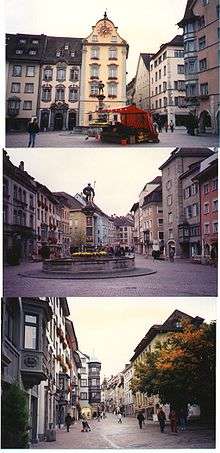
Schaffhausen has a population (as of December 2015) of 35,948.[11] As of 2014, 27.9% of the population are resident foreign nationals.[12] Of the foreign population, (as of 2008), 21% are from Germany, 13.3% are from Italy, 8.8% are from Croatia, 13.3% are from Serbia, 6% are from Macedonia, 9% are from Turkey, and 28.6% are from other countries.[13] Most of the population (as of 2000) speaks German (84.3%), with Serbo-Croatian being second most common (3.4%) and Italian being third (3.2%).[14]
Over the last 4 years (2010-2014) the population has changed at a rate of 2.82%. The birth rate in the municipality, in 2014, was 9.6, while the death rate was 10.1 per thousand residents.[8]
As of 2014, children and teenagers (0–19 years old) make up 17.8% of the population, while adults (20–64 years old) are 61.7% and seniors (over 64 years old) make up 20.5%.[8] In 2015 there were 15,288 single residents, 15,287 people who were married or in a civil partnership, 2,119 widows or widowers, 3,253 divorced residents and 1 people who did not answer the question.[15]
In 2014 there were 16,723 private households in Schaffhausen with an average household size of 2.10 persons. Of the 5,863 inhabited buildings in the municipality, in 2000, about 51.5% were single family homes and 29.7% were multiple family buildings. Additionally, about 22.1% of the buildings were built before 1919, while 7.6% were built between 1991 and 2000.[16] In 2013 the rate of construction of new housing units per 1000 residents was 1.29. The vacancy rate for the municipality, in 2015, was 0.71%.[8]
Historic Population
The historical population is given in the following chart:[17]
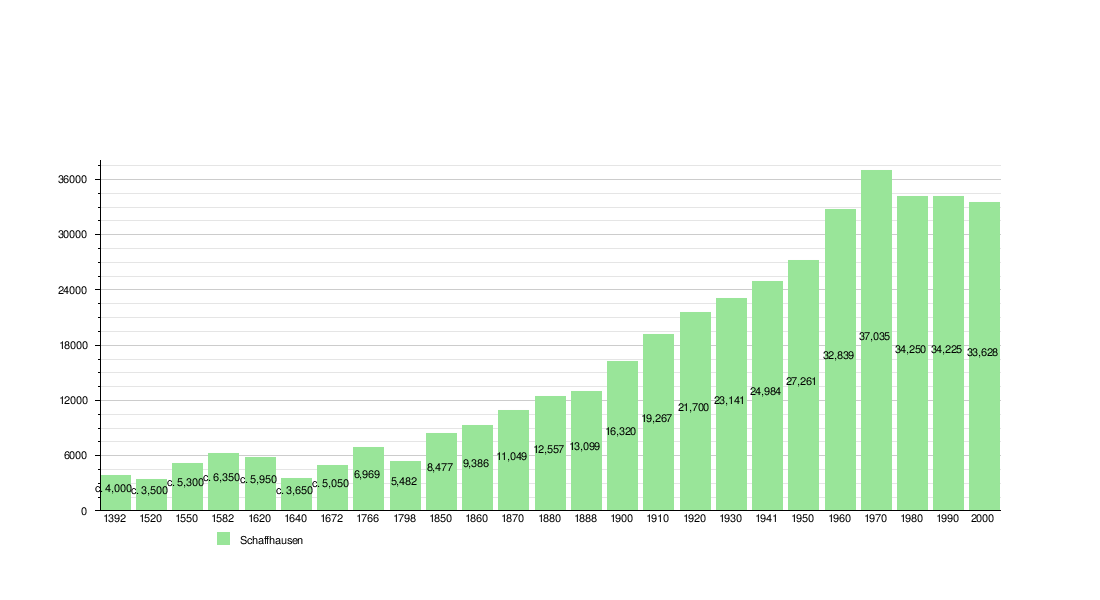
Politics
In the 2015 federal election the most popular party was the SVP with 39.0% of the vote. The next three most popular parties were the SP (34.0%), the FDP (12.7%) and the Übrige (6.7%). In the federal election, a total of 13,754 votes were cast, and the voter turnout was 60.7%. The 2015 election saw a change in the voting when compared to 2011. The percentage that the SP received dropped from 41.6% to 34.0% while the SVP increased from 31.9% in 2011 to 39.0% in 2015.[18]
In the 2007 federal election the most popular party was the SP which received 39.5% of the vote. The next two most popular parties were the SVP (33.1%), and the FDP (27.4%).[14]
Religion
As of 2000, 27.4% of the population belonged to the Roman Catholic Church and 43.6% belonged to the Swiss Reformed Church,[13] later organized in the parish St. Johann – Münster.[19]
Education
In Schaffhausen about 69.8% of the population (between age 25-64) have completed either non-mandatory upper secondary education or additional higher education (either university or a Fachhochschule (university of applied sciences)).[14] In Schaffhausen, as of 2007, 1.73% of the population attend kindergarten or another pre-school, 5.65% attend a Primary School, 2.98% attend a lower level Secondary School, and 2.49% attend a higher level Secondary School.[13]
Economy
As of 2013, there were a total of 25,749 people employed in the municipality. Of these, a total of 103 people worked in 24 businesses in the primary economic sector. A majority (61.2%) of the primary sector employees worked in very small businesses (less than ten employees). The remainder worked in 2 small businesses with a total of 40 employees. The secondary sector employed 6,403 workers in 371 separate businesses. In 2014 a total of 2,433 employees worked in 358 small companies (less than 50 employees). There were 13 mid sized businesses with 1,631 employees and 3 large businesses which employed 2,333 people (for an average size of 777.7). Finally, the tertiary sector provided 19,243 jobs in 2,626 businesses. In 2014 the tertiary sector numbers had increased by 606 and 20 respectively. In 2014 a total of 12,890 employees worked in 2,597 small companies (less than 50 employees). There were 45 mid sized businesses with 4,938 employees and 4 large businesses which employed 2,021 people (for an average size of 505.3).[20]
In 2014 a total of 1.3% of the population received social assistance.[8]
In 2015 local hotels had a total of 102,537 overnight stays, of which 52.6% were international visitors.[21] In 2015 there were two movie theaters in the municipality, with a total of 10 screens and a total of 1,816 available seats.[22] As of 2008, there are 102 restaurants, and 11 hotels with 445 beds. The catering industry in Schaffhausen employs 924 people.[13]
As of 2008 the mid year average unemployment rate was 2.5%. There were 1,879 non-agrarian businesses in the municipality and 29.9% of the (non-agrarian) population was involved in the secondary sector of the economy while 70.1% were involved in the third. At the same time, 67.1% of the working population was employed full-time, and 32.9% was employed part-time. There were 21,841 residents of the municipality who were employed in some capacity, of which women made up 46.6% of the workforce. As of 2000 there were 10,019 residents who worked in the municipality, while 5,724 residents worked outside Schaffhausen and 8,026 people commuted into the municipality for work.[13]
Schaffhausen has an unemployment rate, as of 2007, of 2.67%. As of 2005, there were 196 people employed in the primary economic sector and about 33 businesses involved in this sector. 6,488 people are employed in the secondary sector and there are 293 businesses in this sector. 14,019 people are employed in the tertiary sector, with 1,486 businesses in this sector.[14]
Schaffhausen hosts some well-known industrial companies like Georg Fischer (piping systems, machine tools and automotives), an internationally reputed manufacturer of watches (IWC), pharmaceutical industry (Cilag, founded by Bernhard Joos) and BB Biotech (biotechnologies). Tyco International and Garmin are also incorporated in Schaffhausen.
Transportation
The city of Schaffhausen is served by two railway stations. Schaffhausen railway station is jointly owned by the Swiss Federal Railways (SBB) and Deutsche Bahn (DB), and is served by trains of both nation's networks. The station is served by long distance passenger trains running between Frankfurt and Zurich and between Basel and Ulm. Trains of Zurich S-Bahn services S16, S22 and S33 serve the station, although only the S16 provides a direct service to Zurich. Services S3 and S8 of the St. Gallen S-Bahn operate over the Lake line to St. Gallen and Rorschach respectively. Herblingen railway station is called at by local trains linking Schaffhausen station and Singen.
Schaffhausen also has a bus network of six lines, including the Schaffhausen trolleybus system, linking it with nearby places such as Herblingen and Neuhausen am Rheinfall.
Sport
The town has two football teams, SV Schaffhausen of the fourth tier, the Swiss 1. Liga, and FC Schaffhausen of the Swiss Challenge League. There is a football stadium in Breite, Schaffhausen which seats 4200 persons, known as the Breitestadion. It is also the training headquarters for local children's football teams.
There is a handball team in Schaffhausen which plays in the first Swiss division : Kadetten Schaffhausen. They are centered at the BBC Arena on Schweizersbildstrasse. It seats 3600 persons, and was built in 2011.[23]
Heritage sites of national significance
There are 35 buildings or sites in Schaffhausen that are listed as Swiss heritage sites of national significance. This includes the entire old city of Schaffhausen, the city walls, the Giesserei +GF+ Werk I factory, the city and cantonal archives, the Schweizersbild Paleolithic cave and the Herblingen and Grüthalde Neolithic settlements. Additionally, there are four former guild houses and seven listed houses. There are only two listed religious buildings, the former Benedictine All Saints Abbey and the Church of St. John.[24]
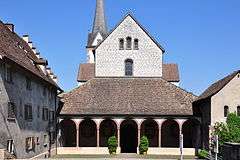 Church portal of Münster Schaffhausen
Church portal of Münster Schaffhausen Cathedral interior of Münster Schaffhausen
Cathedral interior of Münster Schaffhausen Restaurant Thiergarten and Munot tower
Restaurant Thiergarten and Munot tower
 House zum Ritter at Vordergasse 65, one of the listed houses
House zum Ritter at Vordergasse 65, one of the listed houses- View of the Altstadt with the Münster
Crime
In 2014 the crime rate, of the over 200 crimes listed in the Swiss Criminal Code (running from murder, robbery and assault to accepting bribes and election fraud), in Schaffhausen was 63.1 per thousand residents, slightly lower than the national average (64.6 per thousand). During the same period, the rate of drug crimes was 10.5 per thousand residents, similar to the national rate. The rate of violations of immigration, visa and work permit laws was 3.6 per thousand residents, which was only 73.5% of the rate for the entire country.[25]
See also
References
- 1 2 Arealstatistik Standard - Gemeindedaten nach 4 Hauptbereichen
- ↑ Swiss Federal Statistical Office - STAT-TAB, online database – Ständige und nichtständige Wohnbevölkerung nach institutionellen Gliederungen, Geburtsort und Staatsangehörigkeit (German) accessed 30 August 2016
- ↑ Bundesamt fur Statistik (Federal Department of Statistics) (2008). "Bilanz der ständigen Wohnbevölkerung (Total) nach Bezirken und Gemeinden" (in German). Retrieved November 5, 2008.
- 1 2 3
 Chisholm, Hugh, ed. (1911). "Schaffhausen (town)". Encyclopædia Britannica. 24 (11th ed.). Cambridge University Press. p. 312.
Chisholm, Hugh, ed. (1911). "Schaffhausen (town)". Encyclopædia Britannica. 24 (11th ed.). Cambridge University Press. p. 312. - ↑ Flags of the World.com accessed 22-December-2009
- ↑ Canton Schaffhausen website-Numbers and facts accessed 18 April 2009. (German)
- ↑ Atkinson, Rick, The Day of the Battle
- 1 2 3 4 5 Swiss Federal Statistical Office - Regional portraits accessed 27 October 2016
- ↑ Schaffhausen in German, French and Italian in the online Historical Dictionary of Switzerland.
- 1 2 "Climate normals Schaffhausen, Reference period 1981−2010" (PDF). Zurich Airport, Switzerland: Swiss Federal Office of Meteorology and Climatology - MeteoSwiss. 2 July 2014. Retrieved 2015-11-21.
- ↑ Swiss Federal Statistical Office - STAT-TAB, online database – Ständige und nichtständige Wohnbevölkerung nach institutionellen Gliederungen, Geburtsort und Staatsangehörigkeit (German) accessed 30 August 2016
- ↑ Federal Statistical Office - Ständige und nichtständige Wohnbevölkerung nach institutionellen Gliederungen, Geburtsort und Staatsangehörigkeit (Land) accessed 31 October 2016
- 1 2 3 4 5 Statistical Office of the Canton of Schaffhausen (German) accessed 2 December 2009
- 1 2 3 4 Swiss Federal Statistical Office accessed 22 December 2009
- ↑ Swiss Federal Statistical Office - Ständige und nichtständige Wohnbevölkerung nach institutionellen Gliederungen, Geschlecht, Zivilstand und Geburtsort (German) accessed 8 September 2016
- ↑ Swiss Federal Statistical Office STAT-TAB - Thema 09 - Bau- und Wohnungswesen (German) accessed 5 May 2016
- ↑ Swiss Federal Statistical Office STAT-TAB Bevölkerungsentwicklung nach institutionellen Gliederungen, 1850-2000 (German) accessed 27 April 2016
- ↑ Swiss Federal Statistical Office - Nationalratswahlen 2015: Stärke der Parteien und Wahlbeteiligung nach Gemeinden (German) accessed 18 July 2016
- ↑ "Die neue Kirchgemeinde St.Johann-Münster". St. Johann, Schaffhausen. Retrieved 2015-01-01.
- ↑ Federal Statistical Office -Arbeitsstätten und Beschäftigte nach Gemeinde, Wirtschaftssektor und Grössenklasse accessed 31 October 2016
- ↑ Federal Statistical Office - Hotellerie: Ankünfte und Logiernächte der geöffneten Betriebe accessed 31 October 2016
- ↑ Swiss Federal Statistical Office - Kinoinfrastruktur nach Gemeinde und Kinotyp (German) accessed 9 August 2016
- ↑ de:BBC-Arena
- ↑ Swiss inventory of cultural property of national and regional significance 21.11.2008 version, (German) accessed 22-December–2009
- ↑ Statistical Atlas of Switzerland accessed 5 April 2016
External links
| Wikivoyage has a travel guide for Schaffhausen. |
| Wikimedia Commons has media related to Schaffhausen. |
| Wikisource has the text of the 1920 Encyclopedia Americana article Schaffhausen. |
- City of Schaffhausen (German)
- Schaffhausen Tourism
- City archives (German)
- U.S. Bombings of Switzerland during World War II
- Historical
- Museum zu Allerheiligen Schaffhausen, retrieved 2016-08-31
